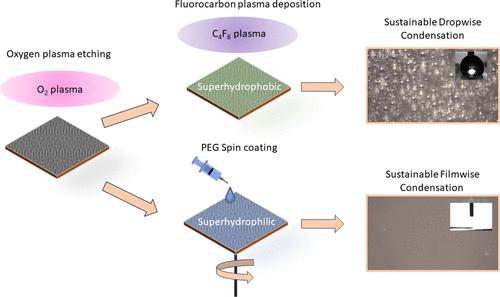具有两种极端润湿性的耐用表面,在液相-气相转换过程中具有稳定的集露性能
IF 3.9
3区 工程技术
Q2 ENGINEERING, CHEMICAL
引用次数: 0
摘要
通过微米和纳米工程,功能表面彻底改变了材料与其环境之间的相互作用,开创了先进材料的新时代。功能表面能够提供广泛的应用,例如防雾、防结冰和防湿。这些表面具有出色的适应性,可提高微流体设备、传感器和微机电系统的性能。超疏水和超亲水表面代表了拒水和吸水性能的顶峰,对于提高露水收集和冷凝相关应用(即热交换器)等应用至关重要。为了实现具有如此显著特性的表面,已经开发出了几种精细的工艺,如今的要求是提高其耐用性、可重复性和可再利用性。在这项工作中,我们介绍了一种超亲水和超疏水表面的制造工艺,该工艺基于氧等离子体微观和纳米挤压,然后通过聚乙二醇(PEG)薄涂层沉积获得超亲水性,通过等离子体沉积 C4F8 获得超疏水性。结果表明,两种极端润湿表面的润湿性能都非常稳定,在环境条件下存放 4 个多月后,水静态接触角(WSCAs)仍能保持稳定,分别为 161°(9 分钟等离子微纳米挤压的超疏水表面)或 0°(9 分钟等离子微纳米挤压和 PEG 涂层的超亲水表面)。超亲水性表面更容易出现润湿性能下降的问题,我们还对其进行了为期 14 天的浸水测试,结果表明,在等离子微纳米纹理表面使用 PEG 涂层可提高超亲水性能的稳定性(WSCA:25°,而未涂层的等离子纹理表面为 63°)。最后,通过露水收集实验对这些表面进行了检测,结果表明这些表面的性能没有明显下降,超疏水性表面在老化过程中(储存后)的集水率(WCR)降低了 20%,而 PEG 涂层的超亲水性表面的集水率降低了不到 5%。超亲水表面更易受湿润影响,因此还对其可重复使用性进行了测试(即多次使用同一表面后),结果发现,WCR 的降低率低于 17%(对于 6 分钟等离子微孔和 PEG 涂层表面)。本文章由计算机程序翻译,如有差异,请以英文原文为准。

Durable Surfaces of Both Wettability Extremes with Stable Dew Harvesting Performance During Liquid–Vapor-Phase Transitions
Leveraging micro- and nanoengineering, functional surfaces revolutionize interactions between materials and their environment, leading to a new era of advanced materials. Functional surfaces are capable of providing a wide range of applications, i.e., antifogging, anti-icing, and antiwetting. These surfaces exhibit remarkable adaptability, improving the performance of microfluidic devices, sensors, and MEMS. Superhydrophobic and superhydrophilic surfaces represent the pinnacle of water repellence and attraction, crucial for enhancing applications like dew water harvesting and condensation-related applications, i.e., heat exchangers. To achieve surfaces with such remarkable properties, several delicate processes have been developed, and today’s request is to improve their durability, repeatability, and reusability. In this work, we present a fabrication process for superhydrophilic and superhydrophobic surfaces based on oxygen plasma micro- and nanotexturing, followed by a thin coating deposition of poly(ethylene glycol) (PEG) for superhydrophilicity and plasma deposition of C4F8 for superhydrophobicity. It is demonstrated that the surfaces of both wetting extremes exhibit remarkable stability in their wetting properties, maintaining stable water static contact angles (WSCAs) of 161° (for the 9 min plasma micronanotextured superhydrophobic surface) or 0° (for the 9 min plasma micronanotextured and PEG-coated superhydrophilic surface) for more than 4 months of storage in ambient conditions. Superhydrophilic surfaces, which are more prone to wetting property deterioration, are additionally tested using water immersion tests for 14 days, and it is shown that the use of the PEG coating on plasma micronanotextured surfaces enhances the superhydrophilic property stability (WSCA: 25° compared to 63° for the uncoated plasma-textured surface). Finally, the surfaces are probed by dew water harvesting experiments in which no significant performance deterioration is observed and water collection rate (WCR) reduction during aging (after storage) is 20% in the case of the superhydrophobic and less than 5% for the superhydrophilic PEG-coated surface. More vulnerable to wetting, superhydrophilic surfaces are also tested in terms of reusability (i.e., after multiple uses of the same surfaces), and it is found that the WCR decrease is less than 17% (for the 6 min plasma micronanotextured and PEG-coated surfaces).
求助全文
通过发布文献求助,成功后即可免费获取论文全文。
去求助
来源期刊

Industrial & Engineering Chemistry Research
工程技术-工程:化工
CiteScore
7.40
自引率
7.10%
发文量
1467
审稿时长
2.8 months
期刊介绍:
ndustrial & Engineering Chemistry, with variations in title and format, has been published since 1909 by the American Chemical Society. Industrial & Engineering Chemistry Research is a weekly publication that reports industrial and academic research in the broad fields of applied chemistry and chemical engineering with special focus on fundamentals, processes, and products.
 求助内容:
求助内容: 应助结果提醒方式:
应助结果提醒方式:


